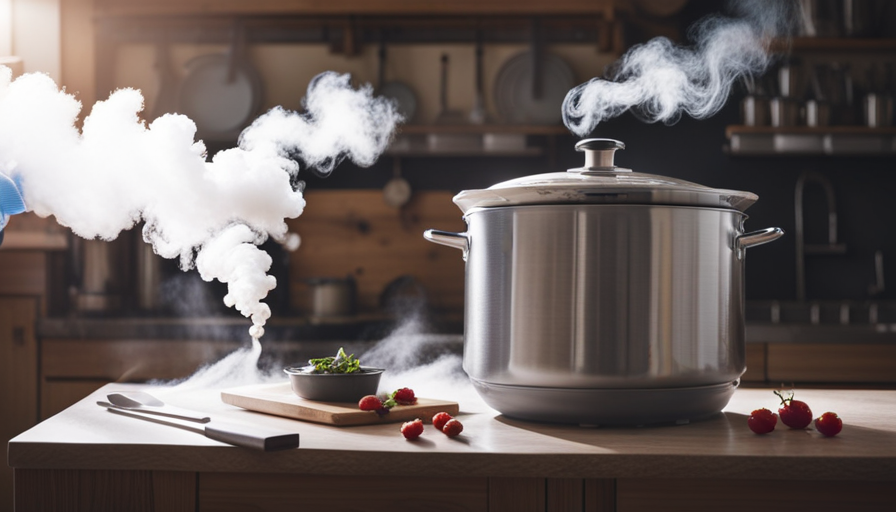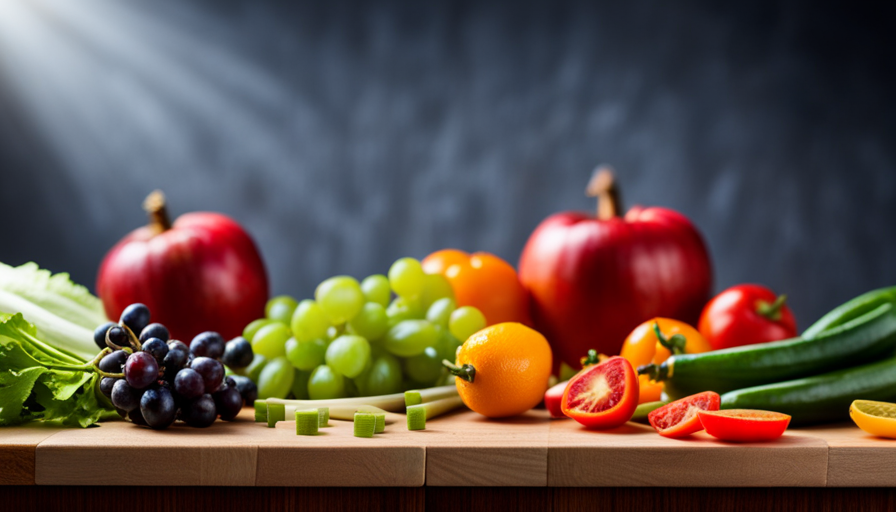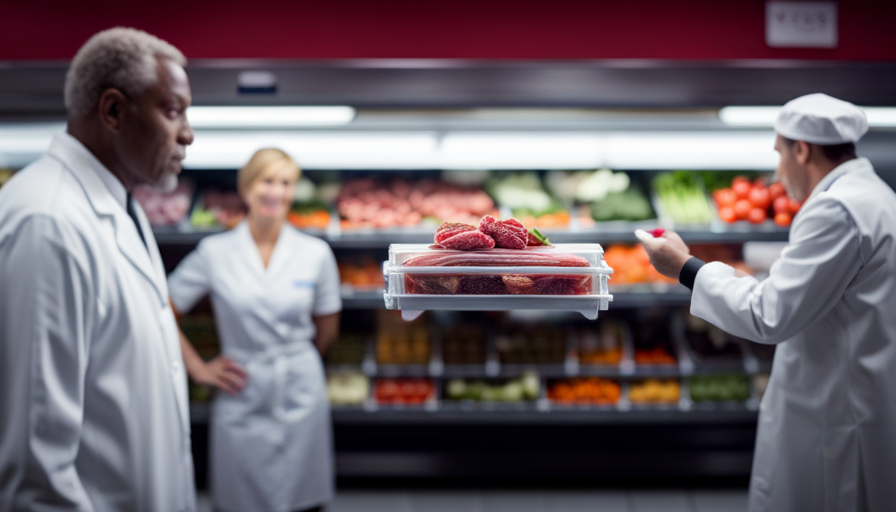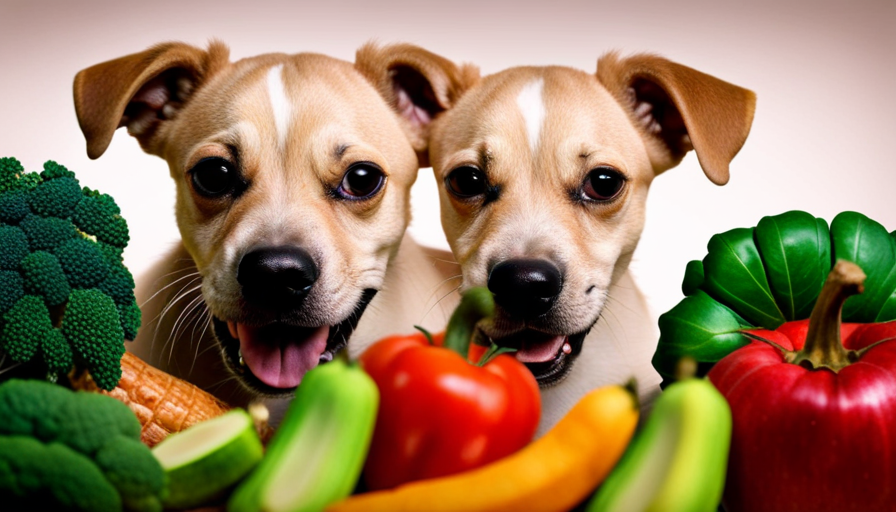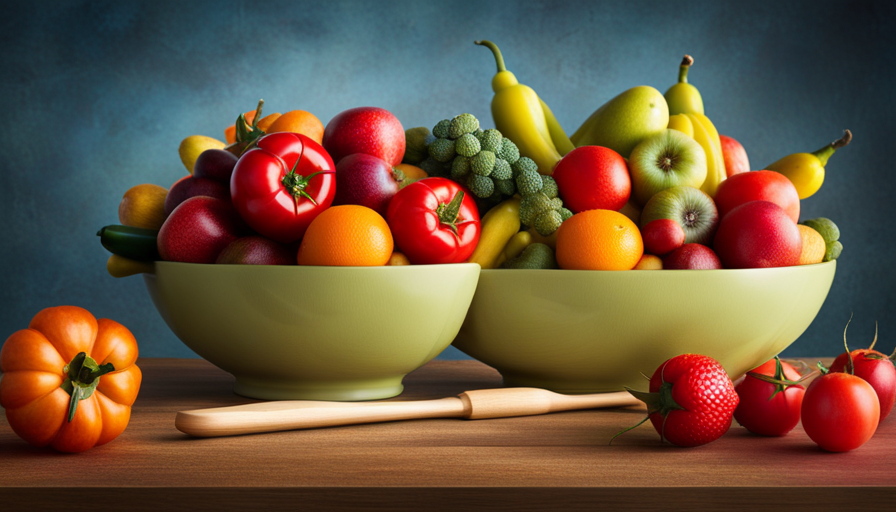Have you ever left your crock pot dirty after cooking raw food in it? It’s a common mistake, but it can be risky. Raw food left in a crock pot can lead to contamination and pose a health risk. Learn how to properly clean your crock pot to stay safe and healthy. Keep reading to find out more!
The good news is that with a few simple steps, you can easily decontaminate your crock pot and ensure its safe use in the future. In this article, we will guide you through the process of decontaminating your crock pot, from assessing the level of contamination to preventing future incidents.
You’ll learn how to:
- Gather the necessary supplies
- Disassemble and clean removable parts
- Soak in hot soapy water
- Scrub and disinfect
- Clean the exterior
- Dry and reassemble your crock pot.
So grab your cleaning supplies and let’s get started on restoring your crock pot to its pristine condition!
Key Takeaways
- Assess contamination by checking for visible signs like mold, discoloration, or foul odors, and considering how long the raw food has been left in the crock pot.
- Gather necessary supplies including mild dishwashing liquid, non-abrasive sponge or cloth, baking soda, and vinegar.
- Disassemble and clean removable parts like the lid, stoneware insert, and handles with warm soapy water.
- Scrub and disinfect the crock pot using hot soapy water and a sponge or cloth, then use a disinfectant spray or water and vinegar mixture to kill germs.
Assessing the Level of Contamination
Now, it’s time for you to determine just how contaminated your crock pot really is. Assessing contamination levels is crucial to understanding the potential health risks associated with the raw food left in it.
Start by inspecting the inside of the crock pot. Look for any visible signs of contamination, such as mold, discoloration, or foul odors. If you notice any of these, it’s a clear indication that the crock pot is heavily contaminated and immediate action is required.
Next, consider how long the raw food has been left in the crock pot. The longer it’s been sitting, the higher the chances of bacterial growth and contamination. If it’s been left for more than two hours at room temperature, the risk of harmful bacteria, like Salmonella or E. coli, increases significantly.
Additionally, think about the type of raw food that was left in the crock pot. Certain foods, like raw poultry or seafood, carry a higher risk of contamination compared to vegetables or fruits. If the raw food was particularly high-risk, it’s important to take extra precautions to decontaminate the crock pot thoroughly.
By assessing the contamination levels, you can better understand the potential health risks associated with the raw food left in your crock pot. This knowledge will guide you in taking the necessary steps to decontaminate it effectively.
Gathering the Necessary Supplies
First, let’s gather all the items you’ll need to restore your crock pot back to its sparkling clean state. Imagine you’re embarking on a culinary quest armed with a trusty arsenal of cleaning supplies. Here are the essential tools you’ll need:
-
Dishwashing liquid: This will be your main weapon against the raw food residue in your crock pot. Choose a mild dishwashing liquid that’s safe for use on cookware.
-
Non-abrasive sponge or cloth: Look for a soft sponge or cloth that won’t scratch the surface of your crock pot. Avoid using abrasive scrubbers that can damage the non-stick coating.
-
Baking soda: This versatile ingredient will help remove any stubborn stains or odors from your crock pot. It acts as a gentle abrasive without scratching the surface.
-
Vinegar: This natural cleaning agent is great for tackling tough stains and disinfecting your crock pot. It can help remove any lingering odor as well.
Before you begin the cleaning process, remember to take some safety precautions. Make sure your crock pot’s unplugged and cooled down completely. Avoid submerging the electric part of the crock pot in water. Also, protect your hands by wearing rubber gloves throughout the cleaning process.
Following these steps and using the right cleaning tools will ensure your crock pot’s decontaminated and ready to use again.
Disassembling and Cleaning Removable Parts
To start the cleaning process, gather all the necessary supplies and begin by disassembling and cleaning the removable parts of your crock pot. Proper maintenance and cleaning techniques are essential to ensure the removal of any remaining raw food and prevent the growth of bacteria.
First, unplug the crock pot and let it cool down completely. Then, carefully remove the lid, stoneware insert, and any other detachable parts. These parts are usually dishwasher safe, but it’s always a good idea to check the manufacturer’s instructions to be sure.
Next, wash the removable parts with warm, soapy water, using a non-abrasive sponge or cloth. Make sure to thoroughly clean all surfaces, including the handles and the underside of the lid. Rinse off any soap residue and dry the parts completely before reassembling the crock pot.
Here’s a handy table to help you keep track of the removable parts and their cleaning instructions:
| Part | Cleaning Instructions |
|---|---|
| Lid | Hand wash only |
| Stoneware insert | Dishwasher safe |
| Handles | Hand wash only |
By following these cleaning techniques and properly maintaining your crock pot, you can ensure that it remains clean and safe for future use.
Soaking in Hot Soapy Water
For a more thorough clean, you can enhance the effectiveness of the cleaning process by soaking the removable parts of your crock pot in hot soapy water. This method, known as the hot water method, can help remove stubborn residue and eliminate any lingering odors. Here’s how you can do it:
- Fill your sink or a large basin with hot water.
- Add a few drops of dish soap to create a soapy solution.
- Take out the removable parts of your crock pot, such as the lid, stoneware insert, and any other detachable components.
- Submerge the parts in the hot soapy water and let them soak for at least 30 minutes.
While the parts are soaking, you can prepare a vinegar solution to further enhance the cleaning process. Mix equal parts of white vinegar and water in a spray bottle. After the soaking time is up, remove the parts from the soapy water and spray them generously with the vinegar solution.
Using a soft sponge or brush, scrub the parts gently to remove any remaining dirt or stains. Rinse the parts thoroughly with warm water to ensure all soap and vinegar residue is removed. Finally, dry the parts completely before reassembling your crock pot.
By following this hot water method and incorporating the vinegar solution, you can effectively decontaminate your crock pot and ensure it’s clean and ready for use.
Scrubbing and Disinfecting
Once you’ve finished soaking the removable parts, it’s time to scrub and disinfect your crock pot to ensure it’s squeaky clean. To do this, you’ll need to gather some cleaning materials such as dish soap, a sponge or soft cloth, and a disinfectant spray. Start by using the sponge or cloth to scrub the interior and exterior of the crock pot with hot, soapy water. Pay extra attention to any stubborn food residue or stains.
Next, it’s important to disinfect the crock pot to eliminate any bacteria or germs that may be present. You can do this by using a disinfectant spray or a mixture of water and vinegar. Spray the disinfectant onto the surfaces of the crock pot and let it sit for a few minutes to ensure all the germs are killed. Then, wipe it down with a clean cloth or sponge.
To help you keep track of the cleaning methods and time required for each step, here’s a handy table:
| Cleaning Method | Time Required |
|---|---|
| Scrubbing with hot, soapy water | 10-15 minutes |
| Disinfecting with disinfectant spray or water and vinegar mixture | 5 minutes |
By following these cleaning methods and taking the required time, you can ensure that your crock pot is thoroughly cleaned and safe to use for your next delicious meal.
Removing Lingering Odors
If you’re tired of your kitchen smelling less than fresh, there’s a simple solution for removing lingering odors from your crock pot. After scrubbing and disinfecting your crock pot to eliminate bacteria, you may still be left with stubborn odors. Luckily, there are natural deodorizers you can use to get rid of those unpleasant smells.
One effective way to remove lingering odors is to use vinegar. Fill your crock pot with equal parts water and white vinegar, and let it sit for a few hours. The acidity of the vinegar helps to neutralize the odors. Afterward, rinse the crock pot thoroughly with water.
Another natural deodorizer you can use is baking soda. Sprinkle a generous amount of baking soda into the crock pot and let it sit overnight. Baking soda is known for its odor-absorbing properties, so it will help to eliminate any remaining smells. In the morning, rinse the crock pot with water and the odors should be gone.
If the odors persist, you can also try placing a few lemon slices in the crock pot and filling it with water. Heat the water on low for a few hours, allowing the citrus scent to permeate the crock pot and eliminate any lingering odors.
By following these simple steps and using natural deodorizers, you can ensure that your crock pot isn’t only free from bacteria but also smells fresh and clean.
Cleaning the Exterior
To tackle the task of cleaning the exterior of your crock pot, start by scrubbing away any stuck-on stains or dirt. Here are four cleaning techniques you can use, using natural products:
-
Vinegar and Baking Soda: Create a paste by mixing equal parts vinegar and baking soda. Apply the paste to the stained areas and let it sit for a few minutes. Scrub the stains away using a soft brush or sponge. Rinse thoroughly with water.
-
Lemon Juice: Cut a lemon in half and rub it directly onto the stains. The acidity in the lemon juice helps to break down the dirt and grime. Wipe clean with a damp cloth.
-
Salt and Vinegar: Mix salt and vinegar to form a thick paste. Apply the paste to the stained areas and let it sit for about 15 minutes. Scrub the stains away using a sponge or cloth. Rinse well with water.
-
Dish Soap and Warm Water: Mix a few drops of dish soap with warm water. Dip a sponge or cloth into the soapy water and gently scrub the exterior of the crock pot. Rinse thoroughly with clean water.
Remember to always dry the exterior of your crock pot thoroughly after cleaning to prevent any water spots or streaks.
Drying and Reassembling
After using one of the cleaning techniques mentioned, it’s important to thoroughly dry the exterior of your crock pot to prevent water spots or streaks. Use a clean, dry cloth to wipe down the entire surface of the crock pot, including the handles and lid. Pay special attention to any crevices or grooves where water may collect. Make sure to remove any excess moisture before moving on to the reassembly steps.
To ensure a thorough drying process, you can also use a hairdryer on a low heat setting. Hold the hairdryer a few inches away from the crock pot and gently blow warm air over the surface. This will help to evaporate any remaining moisture and leave your crock pot completely dry.
Once the exterior is dry, it’s time to reassemble your crock pot. Begin by placing the clean, dry stoneware back into the base. Make sure it fits securely and is centered properly. Next, attach the lid and ensure it is properly aligned and latched. Finally, plug in the crock pot and test that it is functioning correctly before using it again.
Remember, the drying process and reassembly steps are crucial to keep your crock pot in good condition and prevent any potential issues.
Preventing Future Contamination
Now that you’ve successfully dried and reassembled your crock pot, it’s important to take steps to prevent future contamination and maintain proper hygiene. Here are some essential tips to ensure that your crock pot remains clean and safe to use:
-
Cleanliness is key: Always wash your hands thoroughly before handling any food or utensils. This helps prevent the transfer of harmful bacteria onto the surfaces of your crock pot.
-
Use separate cutting boards: To avoid cross-contamination, designate specific cutting boards for raw meats, vegetables, and other ingredients. This will help prevent the spread of harmful bacteria from one food item to another.
-
Cook food to the right temperature: Ensure that your food reaches the recommended internal temperature to kill any bacteria present. Use a food thermometer to accurately measure the temperature.
-
Store leftovers properly: Promptly refrigerate any leftovers in shallow containers to prevent bacterial growth. Avoid leaving food out at room temperature for extended periods.
By following these simple yet crucial steps, you can significantly reduce the risk of future contamination and maintain a hygienic crock pot for delicious and safe meals.
Seeking Professional Help if Needed
If you’re still concerned about the cleanliness of your slow cooker, it may be wise to consult a professional for assistance. Seeking professional help can provide you with expert advice and ensure that your crock pot is thoroughly decontaminated.
When it comes to hiring experts, there are a few options you can consider. One option is to reach out to a professional cleaning service that specializes in kitchen appliances. These professionals have the knowledge and experience to effectively clean and sanitize your crock pot, eliminating any trace of contamination. They can also provide guidance on proper maintenance and preventive measures to avoid future incidents.
Another option is to contact the manufacturer of your slow cooker. They may have a customer service department that can offer guidance or recommend a professional who can assist you. Manufacturers often have specific cleaning instructions tailored to their products, and following these guidelines can ensure the best results.
Remember, seeking professional help is not only about getting the job done right, but also about your peace of mind. By entrusting the cleaning of your crock pot to experts, you can be confident that it will be properly decontaminated and safe to use again.
Frequently Asked Questions
How long does it take for raw food to become contaminated in a crock pot?
Bacteria growth in a crock pot depends on various factors such as temperature, moisture, and food type. Generally, it takes around 2-4 hours for bacteria to start multiplying in a warm and moist environment like a crock pot.
To properly sanitize a contaminated crock pot, start by removing any leftover food, then wash it with warm soapy water. Next, disinfect it by using a mixture of water and bleach or vinegar. Rinse thoroughly and air dry before using again.
Can I use bleach to disinfect the removable parts of the crock pot?
Yes, you can use bleach to disinfect the removable parts of your crock pot. However, there are alternative methods for decontaminating your crock pot as well. One alternative method is to use a mixture of vinegar and water to clean the removable parts. Another option is to use hot, soapy water followed by a thorough rinse. Whichever method you choose, make sure to thoroughly clean and rinse the removable parts to ensure they’re properly disinfected.
Are there any specific cleaning products that should be avoided when cleaning a crock pot?
Avoid using harsh chemicals or abrasive cleaners when decontaminating your crock pot. These products can damage the pot’s surface and leave behind harmful residues. Instead, opt for natural cleaning methods.
Vinegar and baking soda, for example, can effectively remove stains and kill bacteria. Simply mix equal parts vinegar and water, or create a paste with baking soda and water. Let it sit for a few minutes, then scrub gently with a non-abrasive sponge.
How often should I clean my crock pot to prevent future contamination?
To ensure food safety, it’s important to clean your crock pot regularly. A good rule of thumb is to clean it after each use. This will help prevent future contamination and maintain the quality of your meals. There are several effective methods to decontaminate a crock pot, such as using hot soapy water, vinegar, or a mixture of baking soda and water. These methods will help remove any residue and kill bacteria.
What are some common mistakes people make when cleaning a crock pot that can lead to further contamination?
Common misconceptions about cleaning a crock pot can lead to further contamination if not addressed. One common mistake is assuming that a quick rinse will suffice, when in reality, a thorough scrub with hot, soapy water is essential.
Another mistake is neglecting to clean the lid and rubber seal, which can harbor bacteria. To prevent contamination, it’s best to follow these cleaning practices: disassemble all removable parts, soak them in hot water, scrub with a non-abrasive sponge, and air dry completely before storing.
Is it safe to decontaminate a crock pot that had raw food left in it for raw food for cancer?
Decontaminating a crock pot that had raw food left in it is important for raw food cancer treatment. Proper cleaning to remove any harmful bacteria is essential to prevent foodborne illnesses. Make sure to thoroughly wash the pot with hot, soapy water before using it again to prepare raw food for cancer treatment.
Conclusion
In conclusion, cleaning and decontaminating a crock pot after raw food has been left in it is essential to ensure food safety. By following the steps outlined in this article, you can effectively remove any harmful bacteria and prevent future contamination.
Did you know that, according to a study conducted by the U.S. Department of Agriculture, nearly 1 in 4 foodborne illnesses in the United States are caused by improper handling and storage of food? Taking the time to properly clean your crock pot can help reduce the risk of foodborne illnesses and keep you and your family safe.

